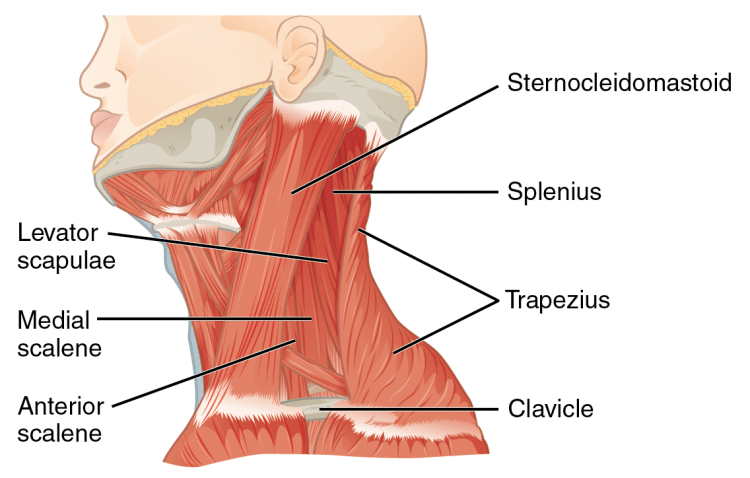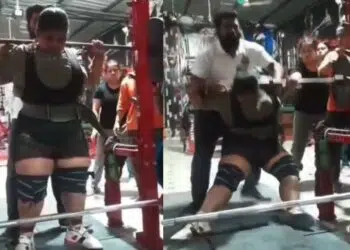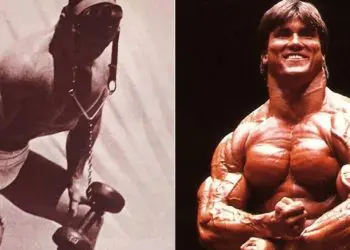Neck training is a traditional part of many sports, including football, boxing, MMA, and wrestling. However, neck exercises have somewhat fallen out of favor in bodybuilding. In fact, very few bodybuilders do much in the way of neck training.
Back in the golden era of bodybuilding, most lifters trained their necks. That’s because the standards of the day suggested that a bodybuilder’s calf, biceps, and neck should all have the same circumference. Therefore, if you had 17” biceps, your neck and calves should measure the same. This “ideal” featured prominently in ancient Greek statues.
So, whether you are a bodybuilder looking to add balance to your physique, an athlete who wants extra protection from impacts, or someone who just wants to develop a more balanced, aesthetic shape, adding some direct neck training to your workouts could be just what’s needed.
In this article, we reveal seven of the best exercises for a thicker, stronger neck.
Neck Anatomy 101
Before we get into the nitty-gritty of the best exercises for a more muscular neck, let’s take a quick look at the muscles and joints that make up this often-under-trained body part. It’s often helpful to know the basic anatomy and physiology of what you are training, so you can choose the best exercises for your goals.

Level Up Your Fitness: Join our 💪 strong community in Fitness Volt Newsletter. Get daily inspiration, expert-backed workouts, nutrition tips, the latest in strength sports, and the support you need to reach your goals. Subscribe for free!
Your neck is made up of seven vertebrae – collectively called your cervical spine. It can perform the following movements:
- Flexion – looking downward
- Extension – looking upward
- Rotation – looking over your shoulder
- Lateral flexion – lowering your ear toward your shoulder
Some of these joint actions can be combined to create additional movements, such as rotation and extension to tilt your head up diagonally.
Your main neck muscles and their primary functions are:
Trapezius
You’re probably already familiar with this muscle and may train it as part of your back or shoulder workouts. There are three trapezius muscles: lower, middle, and upper. The lower and middle trapezius does not affect your neck size. However, the upper traps originate on the base of your skull and cover the back of your neck. They are responsible for the elevation of your shoulder girdle and extension of your cervical spine.
Scalenes
Located on the side of your neck, the primary role of the scalenes is lateral flexion and rotation of your neck. There are three scalene muscles: anterior (front), medial (middle), and posterior (rear). While these muscles have separate origins and insertions, they typically work together to control your cervical spine.
Splenius muscles
his is a group of two muscles: the splenius capitus and the splenius cervices. Their primary function is to extend and rotate your neck. They’re located on the back and side of your cervical spine.
Levator scapulae
Located on the sides of your neck, the levator scapulae work with the upper traps to elevate your shoulder girdle. However, when you hold your shoulders down, these muscles also play a part in neck rotation.
Sternocleidomastoid
This neck muscle has two heads: the sternal head and the clavicular head. Both heads share a common attachment on the temporal bone at the base of the skull. Their main functions are the rotation of your head, as well as flexion of the neck, and pulling your head forward.
Top Exercises for a Thick Neck
So, you want a thicker, more muscular neck? Start by adding some of these exercises to your workout. However, take care not to do too much too soon. Overtraining your neck can lead to severe delayed onset muscle soreness (DOMS) as well as triggering terrible headaches.
1. Weighted shrugs
Weighted shrugs target your upper trapezius, which makes up the side and back of your neck. You can do weighted shrugs with a barbell (in front or in behind of your body), dumbbells, cables, kettlebells, a Smith machine, a trap bar, or using the shoulder pads of a calf raise machine.
With all types of shrugs, focus on pulling your shoulders straight up to your ears. There is no requirement to roll your shoulders backward or forward. Rolling does nothing for your upper trapezius and just increases shoulder joint wear and tear. Leave the rolling shrugs for the guys who don’t know what they’re doing!
Level Up Your Fitness: Join our 💪 strong community in Fitness Volt Newsletter. Get daily inspiration, expert-backed workouts, nutrition tips, the latest in strength sports, and the support you need to reach your goals. Subscribe for free!
You can do shrugs strictly, i.e., just raising your shoulders, or ramp things up with power shrugs, where you dip and then extend your knees to help you lift more weight.
Click on these links to see how to do a variety of weighted shrug exercises:
- Cable shrug with a single pulley
- Cable shrug with two pulleys
- Barbell shrug
- Dumbbell shrug
- Calf raise machine shrug
2. Snatch grip rack pull
A rack pull is a deadlift that starts with the bar resting at around knee height in a power rack. A snatch grip is a very wide, overhand grip. Put these two things together for a highly effective upper back and trap exercise that’ll beef up your neck and entire posterior chain in double-quick time! Once you’ve mastered this exercise, you should be able to lift heavy weights to trigger rapid increases in muscle size and strength.
How to do it:
- Place your barbell in a power rack with the pins set to about knee height.
- Stand behind the bar with your feet about shoulder-width apart.
- Hold the bar with a wide, overhand grip. How wide? About 1 ½ shoulder-widths is usually about right. You may need to use lifting straps or a hook grip for this exercise.
- Bend your legs lightly, hinge forward from your hips, pull your shoulders down and back, and brace your core.
- Keeping your arms straight, your shoulders back, and without rounding your lower back, extend your knees and drive your hips forward to stand up.
- Lower the bar back to the pins, reset your grip, core, and shoulders, and repeat.
3. High pulls
Olympic lifters often have very well-developed upper backs and necks. This exercise could be one of the reasons why! It’s a cross between a Romanian deadlift, power clean, and upright row. As such, it allows you to lift heavy weights and expose your upper back and traps to heavy weights and lots of muscle tension.
This is an explosive exercise which means it’s ideal for athletes looking to increase lower and upper body power, as well as bodybuilders who want to get yoked.
How to do it:
- Hold a barbell with a wide, overhand grip. The bar should be roughly level with your hips, so move your hands in or out to achieve the desired height.
- Brace your core and pull your shoulders down and back.
- Bend your knees slightly and hinge forward at the hips, lowering the bar to just above or just below your knees. Do not round your lower back.
- Stand up quickly, shrug your shoulders, and pull the bar up the front of your body to your chest.
- Hold the uppermost position for a split second before lowering the bar and repeating.
4. Neck extensions
Neck extensions target the muscles on the back of your neck. You can do neck extensions using a weighted harness, while holding a weight plate on the back of your head, or with a resistance band. A resistance band is arguably the most convenient, comfortable, and joint-friendly variation.
Start with a light band and do an easy workout of 2-3 sets of 6-8 reps. This should be enough to stimulate muscle growth without triggering unpleasant soreness. Increase the intensity and volume of your neck training as you get used to it.
How to do it:
- Loop a resistance band over the back of your head. Seated or standing as preferred, lean forward and secure the other end of the band by standing on it or hooking it under a dumbbell. Hold the band just below your head to stop it from slipping off.
- Lower your chin toward your chest.
- Lift your head and look up toward the ceiling.
- Lower your head and repeat.
5. Weighted lateral neck flexion
This exercise specifically targets the muscles on the side of your neck. Developing these muscles will make your neck wider. You can do this exercise using a weighted neck harness, but, more conveniently, it can also be done using a weight plate or ankle weight. If using a weight plate, wrap it in a towel to protect your head.
How to do it:
- Lie on your side on the floor or on a bench. Rest and hold your chosen weight on the uppermost side of your head. Hold it in place with your hand.
- Lower your ear down toward your shoulder, and then raise your head back up again.
- Take care not to turn your head; this is a lateral flexion and not a rotation exercise.
6. Lying neck flexion
This simple bodyweight neck exercise targets the muscles on the front of your neck. These muscles don’t do a lot for the thickness of your neck, but they’re essential in contact and combat sports like football and boxing as they stop your head from being rocked backward.
However, if you spend a lot of time sitting hunched over a computer, the anterior neck muscles may already be tight and strong, so you may not need to do this exercise.
How to do it:
- Lie on the floor with your legs bent and feet flat. Relax your arms and shoulders.
- Tuck your chin in toward your chest and then curl your head up so you can see down the front of your body.
- Lower your head back to the floor and repeat.
- You can also do this exercise while lying on an exercise bench so that you can move your head through a greater range of motion.
- Make this exercise harder by holding a weight plate wrapped in a towel or an ankle weight on your forehead.
7. Stability ball neck bridge
Neck bridges are a common part of boxing and wrestling training. However, while bridges can be effective for increasing neck size, they can also be painful and even dangerous. This variation is still effective but much more cervical spine friendly. Even so, it’s still a challenging exercise so take it easy if you are new to neck training.
How to do it:
- Sit on a stability ball. Brace your abs and pull your shoulders down and back.
- Walk your feet forward and lie back on the ball. Let the ball roll up your back until just the back of your head is in contract with it.
- Lift your hips and extend your neck by pushing the back of your head into the ball.
- Hold this position for 10-15 seconds and then walk your feet back in and sit up.
- Increase the duration of each hold as you get stronger.
Wrapping Up
A lot of bodybuilders don’t train their necks. This may be because they’re genetically blessed with muscular necks or just don’t want to develop such a thick neck that it detracts from their overall appearance.
However, some exercisers would benefit by adding a couple of inches to their neck size.
If your neck is a little too skinny for your liking, use the exercises in this guide to build it up. You won’t need to dedicate a lot of time and energy to neck training as a little goes a long way. All you need is a couple of brief workouts a week.
You can even work on your neck size at home, using nothing but resistance bands, a stability ball, or even just your body weight.
But, if those calls of “hey, pencil neck” are starting to wear you down, it’s time to take steps to remedy the situation with some neck specialization training.
Interested in measuring your progress? Check out our strength standards for Upright Row, Rack Pull, Dumbbell Shrug, and more.








